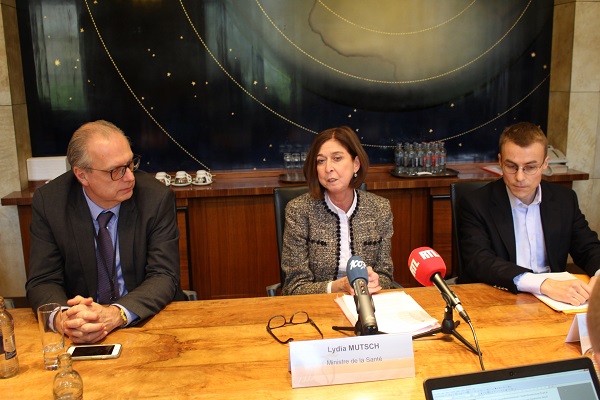 (L-R): Dr Jean-Claude Schmit, directeur de la Santé; Lydia Mutsch, Minister of Health ; Laurent Mertz, service juridique du ministère de la Santé;
Credit: MSAN
(L-R): Dr Jean-Claude Schmit, directeur de la Santé; Lydia Mutsch, Minister of Health ; Laurent Mertz, service juridique du ministère de la Santé;
Credit: MSAN
In accordance with the Luxemboug Government's programme on non-conventional medicine, which specifies that priority will be given to the regulation of the osteopathic profession, the Ministry of Health has laid down the legal and regulatory procedures for the establishment of the profession of osteopathy; tis work was done in close collaboration with the Luxembourg Association of Osteopaths (ALDO).
On 6 December, the Council of Government adopted the draft Grand-Ducal Regulation amending the amended law of 26 March 1992 on the exercise and revaluation of certain health professions, in order to create the profession of osteopath. Such a regulation proves to be indispensable considering the fact that many patients resort to this therapy which enters more and more in their care path and brings certain improvements to their state of health.
"The regulation of the osteopathic profession provides the patient with greater security first. The absolute priority of the regulation of this health profession is thus the access to the patient to an osteopath who has followed a rigorous and serious training since, in the absence of such a regulation, anyone could declare himself an osteopath" said Health Minister Lydia Mutsch.
Osteopaths must also now have prior authorisation from the Ministry of Health to practice the profession and will appear in the professional register kept by the Ministry.
The safety of the patient is increased for the reason that in certain situations, specified by the project, the collaboration between osteopaths and doctors will be regulated.
Thus, there are cases where the intervention of the osteopath requires a prior medical diagnosis (e.g. manipulations of the skull, face and spine in infants less than six months old, manipulation of the cervical spine). In addition, the osteopath will be obliged to refer the patient to a physician, when the symptoms require a diagnosis or medical treatment, when it is found that these symptoms persist or worsen or that the disorders presented exceed his or her field of action and skills.
The practice of medicine will remain reserved for medical providers who have graduated.
Key points of the regulation
The practice of the osteopathic profession is subject to the acquisition of a master's degree in osteopathy or a higher education qualification equivalent to the master's degree.
In order to guarantee the safety of the patient, the completion of an obligatory 40-hour annual continuous training is essential for the treatment of the osteopath to take into account the latest developments in the profession.
"Thanks to the follow-up of the continuous training, the patient can count on a quality and safe treatment. The well-being and safety of the patient is the overriding goal of recognition and regulation of the osteopathic profession," insisted Minister Mutsch.
The tasks of the osteopath include manipulations with the sole purpose of preventing or remedying functional disorders of the human body, among which include manipulations that are of musculoskeletal and myofascial nature. The osteopath is authorised to practice the techniques listed in the preliminary draft of the Grand-Ducal Regulation and which correspond to European standards.
Regarding transitional provisions, osteopaths who do not have a master's degree in osteopathy, regularisation is possible for a transitional period of 6 months from the publication of the Grand-Ducal Regulation for doctors, masseurs, physiotherapists, midwives or licensed nurses who demonstrate a 10-year practice of osteopathy.








